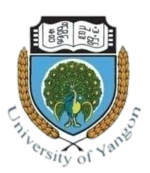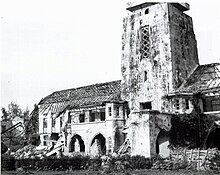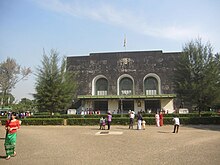University of Yangon
 Seal of Yangon University | |
Former names |
|
|---|---|
| Motto | နတ္ထိ ဝိဇ္ဇာ သမံ မိတ္တံ (Pali:natthi vijjā samaṃ mittaṃ)[1][2][3] |
Motto in English | There's no friend like wisdom. |
| Type | Public |
| Established | 1878 |
| Rector | Dr. Tin Mg Tun |
Academic staff | 1313 |
| Undergraduates | 4194 |
| Postgraduates | 5748 |
| Location | ,, 16°49′48″N96°08′06″E/ 16.83000°N 96.13500°E |
| Campus | Urban |
| Affiliations | ASEAN University Network(AUN),ASAIHL |
| Website | uy |
TheUniversity of Yangon(alsoYangon University;Burmese:ရန်ကုန် တက္ကသိုလ်,pronounced[jàɰ̃ɡòʊɰ̃tɛʔkəθò];formerlyRangoon College,Rangoon UniversityandRangoon Arts and Sciences University), located inKamayut,Yangon,is the oldest university in Myanmar's modern education system and the best known university inMyanmar.The university offers mainly undergraduate and postgraduate degrees (Bachelor's, Master's, Post-graduate Diploma, and Doctorate) programs inliberal arts,sciencesandlaw.Full-time bachelor's degrees were not offered at the university's main campus after the student protests of 1996. The bachelor's degree was re-offered from 2014 on. Today degrees in Political Science are offered to undergraduate students, as well as postgraduate diplomas in areas such as social work and geology.
Initially most major universities in the country depended on Yangon University. Until 1958 whenMandalay Universitybecame an independent university, all institutions of higher education in Myanmar were under Yangon University. After the University Education Act of 1964, allprofessionalcolleges and institutes of the university such as theInstitute of Medicine 1,Rangoon Institute of TechnologyandYangon Institute of Economicsbecame independent universities, leaving the Yangon University with liberal arts, sciences and law. In Myanmar, responsibility for higher education depends on various ministries. The University of Yangon depends from the Ministry of education.[4]
Yangon University has been at the centre of civil discontent throughout its history. All three nationwide strikes against theBritish administration(1920, 1936 and 1938) began at Rangoon University. Leaders of the Burmese independence movement such as GeneralAung San,U Nu,Ne WinandU Thantare some of the notable alumni of the university. The tradition of student protest at the university continued in the post-colonial era—in 1962, 1974, 1988 and in 1996.[5]
History
[edit]Established in 1878 as anaffiliated collegeof theUniversity of Calcutta,theRangoon Collegewas operated and managed by the Education Syndicate set up by theBritish colonial administration.[4]The college was renamed Government College in 1904, and University College in 1920. Rangoon University was founded in 1920, when University College (Rangoon College - secular) and Judson College (Baptist-affiliated) were merged by the University of Rangoon Act.[6]TheAmerican BaptistMission decided to recognize Judson College (formerly Baptist College) as a separate institution within Rangoon University.[4]Rangoon University modelled itself afterUniversity of CambridgeandUniversity of Oxford.[7]All subsequent institutions of higher learning founded by the British were placed under Rangoon University's administration:Mandalay Collegein Mandalay in 1925,Teachers Training CollegeandMedical Collegein Yangon in 1930, andAgriculture Collegein Mandalay in 1938.[8]

Although it was attended only by the elites of the day, the university was at the centre of the Burmese independence movement. Students protested against the British administration's control of the university and the Rangoon Act which placed the governor as chancellor of the University of Rangoon.[6]All three nationwide strikes against the British colonial government (1920, 1936 and 1938) began at the university.National Dayin fact commemorates the rebellion of Burmese students at Rangoon University in 1920. By the 1930s the university was the hotbed of Burmese nationalism, producing a number of future senior Burmese politicians, including GeneralAung San,U Nu,Ba Maw,Kyaw Nyein,Ba Swe,U ThantandThein Pe Myint.
Rangoon University became one of the most prestigious universities inSoutheast Asiaand one of the top universities in Asia, attracting students from across the region.[7][9][10]The Japanese occupied the university during the Second World War, but it recovered and flourished after Burma gained independence in 1948. This golden period ended in 1962.[6]
After themilitary coupof 1962 under GeneralNe Win,and under theBurmese Way to Socialism,Rangoon University was put directly under the control of the Directorate of Higher Education, a central government agency, whereas previously it was run by a council of professors, scholars and government officials.[7]In addition, themedium of instructionwas changed toBurmese,a radical departure fromEnglish,which had been the university's medium of instruction since its founding. Educational standards began to decline markedly, and international bodies ceased to recognizedegreesissued or obtained at the university.[7]The university was also renamed the Rangoon Arts and Sciences University (abbreviated RASU), after certain departments and faculties (medicine, economics, education, etc.) were separated from the university in 1964.

Rangoon University students staged a peaceful demonstration and protest on campus against 'unjust university rules' on7 July 1962.Ne Win sent his troops to disperse the students. Dozens of students were killed and the historic Rangoon University Student Union (RUSU) was reduced to rubble the next morning.[6]
In November 1974 the formerUN Secretary GeneralU Thantdied, and on the day of hisfuneral on 5 December1974, Rangoon University students snatched his coffin on display at the Kyaikkasan Race Course, and erected a makeshiftmausoleumon the grounds of the RUSU in protest against the government for not honouring their famous countryman with astate funeral.The military stormed the campus on 11 December killing some of the students, recovered the coffin, and buried U Thant at the foot of theShwedagon Pagoda.

Student protests against protest against General Ne Win's socialist government culminated in 1988. Student protest in March 1988 was met with a violent response from the government.[11]This did not stop the protests. On 8 August 1988, students around the country came together to protest against the military regime. The protest was supported by hundreds of thousands of people who went into the street in protest against the military rule. This is today remembered at the8888 uprising.The movement was crushed by the army Chief of Staff General Saw Maung who took over and instated the State Law and Order Restoration Council (SLORC or na wa ta). It is estimated that more than 300 students died in the protests. In the months and years that followed, many more were imprisoned.[6]
In 1989, the military junta changed place names throughout Myanmar; the university was renamed the University of Yangon. The university was closed for most of the 1990s, because of fears of a repeat of the8888 Uprising.To prevent students from congregating, the government dispersed the existing institutions and departments that made up Yangon University into separate learning institutions scattered throughout the city. Till 2013 onlygraduate studies,certain professional courses, and a few diploma courses were conducted at the university's maincampus.Newer universities such asDagon University,University of East YangonandUniversity of West Yangonwere created to cater for undergraduates.[12]

Yangon University celebrated itsDiamond Jubileein a week-long celebration, which began on 1 December 1995. The Jubilee marked the school's formal establishment of 75 years. For its commemoration, the government built the Diamond Jubilee Hall, a four-storied building in the university's grounds, which costKs.63,00,00,000. A new set of postage stamps was also produced.[13]Once-affiliated institutes and departments (e.g., theInstitute of Economics, Yangonwhich began life as a department at Yangon University), which had already separated, also celebrated.
The transition to a new government in 2011Myanmarwas followed by a renewed focus on education. In 2013, Aung San Suu Kyi was named head of theYangon University Upgrading and Restoration Committee.[6]In December 2013, the university re-opened for undergraduate students. Initially only 50 undergraduate students were accepted.[6]A controversialNational Education Lawwas enacted in 2014. Under the law the university is managed by the Ministry of Education, who also appoints the university rector.
Campus
[edit]




Yangon University is located in Yangon, along the southwestern bank ofInya Lake,the largest lake in the city. It is on the corner of Pyay Road and University Avenue Road in Kamayut Township, north of downtown Yangon. The modern campus of Yangon University completed construction in 1920. There are two campuses, namely Main Campus and Hlaing Campus, the former being the most well-known. Judson Church, inside the main campus of the university, is a Baptist church, and like Judson College, named afterAdoniram Judson,a 19th-century American missionary who compiled the first Burmese-English dictionary. The main campus also contains a convocation hall.
Housing
[edit]The accommodation in Burma is not mixed and the availability is limited. Women's halls have many restrictive rules whilst men's a few.
|
|
|
Other important buildings
[edit]- Arts Building
- Convocation Hall
- Judson Church
- Recreation Centre
- Science Building
- Universities' Central Library
- Universities' Dhamma Hall
- Universities' Sanatorium
- University Diamond Jubilee Hall
- Universities' Hospital
- University of Yangon Library
- University Post Office
- Painters' House
Main Departments
[edit]- Department ofAnthropology
- Department ofArchaeology
- Department ofBotany
- Department ofChemistry
- Department ofComputer Studies
- Department ofEnglish
- Department ofGeography
- Department ofGeology
- Department ofHistory
- Department ofIndustrial Chemistry
- Department ofInternational Relations
- Department ofLaw
- Department ofLibrary and Information Studies
- Department ofMathematics
- Department ofMyanmar
- Department ofOriental Studies
- Department ofPhilosophy
- Department ofPhysics
- Department ofPsychology
- Department ofZoology.
- Department ofBiology
Each department offers an undergraduate degree programme. The Department of International Relations offers two: the Bachelor of Arts (international relations) and the Bachelor of Arts (political science).
Programmes
[edit]Yangon University offers undergraduate and postgraduate degree programmes. The undergraduate programmes are subdivided into three categories: Arts (B.A.), Sciences (B.Sc.), and Law(LL.B). The choice of different fields of learning takes place in upper secondary school where students choose particular subjects directed towards their tertiary education. Postgraduate degrees are separated into three groups: Doctorates, Master's, and diplomas. Although YU no longer offered the undergraduate degrees owing to the uprising in 1996, it now was reopened for the undergraduate degrees with the name of (COE) what literally meansCenter of Excellencein 2014 and accepted only 50 selectively excellent students for each field of studies. (Although undergraduate and postgraduate programmes are still available to current days, the recognition of status of international COE of the university has been discontinued.)
Notable alumni
[edit]Academia
[edit]- Benjamin Peary Pal:the first Director ofIndian Council of Agricultural Researchand one of the foremost scientists in Wheat genetics and breeding.[14]
- Hla Pe:Linguist, Professor of Burmese language and culture at theUniversity of London(1966– 1980) and one of the compilers of a Burmese-English dictionary
- Hla Myint:Economist and one of the pioneers ofdevelopment economics
- Htin Aung:one of the founding fathers of theAssociation of Southeast Asian Institutions of Higher Learning(ASAIHL)
- Mi Mi Khaing:Scholar and Writer
- Muhammad Siddiq Khan:Bangladeshilibrarian, and the founder of Department ofLibrary Scienceof theUniversity of Dhaka
- Nanda Thein Zan:Writer of texts on philosophy and Buddhism
- Sao Saimong:Scholar and linguist, well known for reformedShan script
- Sein Tu:Psychologist
- Pessie Madan:Indian leader of the high-technology research and development sector
- Pe Maung Tin:Scholar on Pali and Buddhism
- Pho Kyar:Novelist and education reformist
- Ronald Findlay:Ragnar Nurkse Professor of Economics at Columbia University.
- Sir Taw Sein Ko(1864–1930): Burma's first recorded archaeologist and an interlocutor between KingThibawand the British administration
- Than Tun:Historian
- Thaw Kaung:Librarian and a well-known expert in Asianlibrary science
- U Myint:Economist[15]
- U Nyun:Economist and Executive Secretary ofUnited Nations Economic and Social Commission for Asia and the Pacificfrom 1959 – 1973
- Kyaw Thet:Historian
- Winston Set Aung:EconomistandDeputy Governorof theCentral Bank of Myanmar
- Yin Yin Nwe:Geologist and Myanmar's Chief Education Adviser toMyanmar PresidentThein Sein
- Yoshio Nishi:Japanese scholar ofTibeto-Burman linguistics
Arts and literature
[edit]- Ba Gale:Cartoonist
- Kyi Aye:Burmesepsychiatrist,poet, novelist, and short story writer
- Collegian Ne Win:Film actor and footballer
- Khin Myo Chit:Writer and journalist
- Kyi Soe Tun:Film director
- Than E:Singer
- Ludu Daw Amar:Leader of the Rangoon University students strike of 1936, writer and journalist
- Min Thu Wun:[16]Mon-Burmese scholar and poet
- Mya Than Tint:Novelist, Translator
- Saya Zawgyi:Writer and part of theKhit-Sanliterary movement (did not complete degree)
- Thein Pe Myint:Writer, journalist and secretary general ofCommunist Party of Burma
- Theippan Maung Wa:Writer and part of theKhit-Sanliterary movement in the 1930s
- Maung Htin:Writer and part of Khit-San literary movement
- Myo Min(Ngwe Soe): Writer and part of Khit-San literary movement
- Tin Maung:Film actor and director
- Wah Wah Win Shwe:Actress
- Nwe Yin Win:Singer
- Kyaw Thu:Actor and chairman ofFree Funeral Service Society
Business
[edit]- Ezra Solomon:USeconomistand Economic Adviser of US PresidentRichard Nixon
- Khin Maung Aye: Chairman ofCB Bankand Chairman of Myanmar Banks Association[17]
- Lim Chin Tsong:A tycoon in the early 20th century and a member of theLegislative Council of Burma
- Michael Moe Myint:Founder ofMyint & Associatesand Myanmar Petroleum Resources Limited (MPRL)
- Zaw Zaw:Founder ofMax Myanmarand vice president ofAsian Football Confederation(AFC)
Politics and government
[edit]- Aung San:National independence figure of Burma and founder of theArmed forces of Myanmar,5th Prime Minister of British Burma
- B. R. Ambedkar:one of the architects of theIndian Constitution
- Ba Cho:Minister of Information 1946–1947
- Ba Maw:Premier of Burma from 1937 to 1939 and Prime Minister 1943–1945 (during WWII)
- Ba Swe:2nd Prime Minister of Burma
- Ba Win:Minister of Trade 1946–1947
- Khin Nyunt:Burmese spy chief and 9th Prime Minister of Burma
- Kyaw Nyein:Deputy Prime Minister of Burma from 1948 to 1949 and again from 1953 to 1958, 1st Burmese Home Affairs Minister
- Ma Saw Sa(Judson College), first Burmese woman physician, suffragist, member of parliament
- Maung Khin:1st Burmese Chief Justice (1921–1924)
- Maung Maung:Chief justices of Burma, Attorney General of Burma, and 7th President of Burma
- Maung Maung Kha:Prime minister of Burma 1977–1988
- Ne Win:Chairman of Revolutionary Council, 4th President and 3rd Prime Minister of Burma
- Pe Khin:Chief architect of thePanglong Agreement
- Shawkat Ali Khan:a framer of theConstitution of Bangladesh
- Thakin Mya:Minister of Home Affairs 1946–1947
- Thit Thit Myint:Burmese politician
- U Nu:1st Prime Minister of Burma
- U Razak:Minister of Education
- U Thant:thethird Secretary-Generalof theUnited Nationsfrom 1961 to 1971
- Usha Narayanan:First Lady of India from 1997 to 2002
- Win Maung:the third President of theUnion of Burma
- Win Myint:the tenth president ofMyanmar
See also
[edit]References
[edit]- ^"THE MOTTO OF THE UNIVERSITY OF YANGON AND THE INFLUENCE OF PALI".MDN - Myanmar DigitalNews.
- ^"ရန်ကုန်တက္ကသိုလ် အမှတ်တံဆိပ်နှင့် ဆောင်ပုဒ်"[Yangon University logo and motto].www.moi.gov.mm(in Burmese).
- ^"ရန်ကုန်တက္ကသိုလ် အမှတ်တံဆိပ်နှင့် ဆောင်ပုဒ် | Myanmar Digital News".
- ^abcJames, Helen (2005).Governance And Civil Society In Myanmar: Education, Health, and Environment.Routledge.ISBN0-415-35558-3.
- ^
Zin Linn (20 November 2012)."President Obama rejuvenates Rangoon University of Burma".Asian Correspondent.Bristol, England: Hybrid News Limited. Archived fromthe original(News & blogging)on 17 January 2013.Retrieved20 November2012.
People of Burma... satisfied with the choice of a venue made by the US President... the convocation hall of the University of Rangoon....
- ^abcdefgShoon Naing and Lun Min Mang (9 August 2016)."'8888 Uprising' remembered in Yangon| ".Myanmar Times.Retrieved2 May2017.[dead link]
- ^abcdKhin Maung Kyi (2000).Economic Development of Burma: a Vision and a Strategy.SUP. p. 150.ISBN91-88836-16-9.
- ^Ko Yin Aung (23 December 1999)."Prospects of education in Myanmar".The New Light of Myanmar.Archivedfrom the original on 3 March 2016.Retrieved24 December2008.
- ^Rothenberg, Daniel (Fall 2002)."Towards a New Modern Developed Nation".Journal of the International Institute.University of Michigan International Institute. Archived fromthe originalon 6 May 2005.Retrieved22 May2006.
- ^Szep, Jason; Raju Gopalakrishnan; Ron Popeski (27 November 2011)."Yangon: From stately city to crumbling symbol of isolation".Reuters.Archivedfrom the original on 12 January 2016.Retrieved3 March2012.
- ^Lone, Wa (8 April 2014)."Red Bridge burns bright for student activists".Myanmar Times.Retrieved3 May2017.[dead link]
- ^James, Helen (2005).Governance and Civil Society in Myanmar: Education, Health and Environment.Routledge. p. 102.
- ^"Myanmar Philately".Tharaphi.Archivedfrom the original on 10 September 2017.Retrieved20 October2008.
- ^"Agriculture"(PDF)..iisc.ernet.in. Archived fromthe original(PDF)on 27 January 2018.Retrieved30 August2015.
- ^Ba Kaung (27 April 2011)."Thein Sein Appoints Presidential Advisors".The Irrawaddy.Archived fromthe originalon 25 July 2015.Retrieved28 March2012.
- ^"Burmese Literary Pioneer".The Irrawaddy.
- ^"CB Bank: Board of Directors".www.cbbank.com.mm.Archived fromthe originalon 14 August 2018.Retrieved15 October2017.
